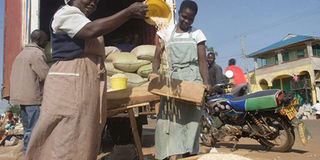Boosting food security amid biting land scarcity: Lessons for Kenya from Singapore

Traders sift their maize ready for sale at a marketplace. In Kenya there is an abundance of idle land which could be put to good use. The Government should consider policies to convince people sitting on large areas of idle land in various parts of the country to rent out these plots for commercial agricultural use, to grow food and other related crops. FILE PHOTO | NMG
What you need to know:
- The government plans to achieve these goals by: First, embracing the concept of multistorey vegetable farms illuminated by LED lighting and recirculating aquaculture systems with potential yields of up 15 times as much as conventional systems.
- This initiative uses applied research and development, strengthening climate-resilience and overcoming resource constraints. All farmers also are to have access to computerised control systems.
- Rather than buy imported foodstuffs, consumers will support the business of their local farmers because local produce is safe and fresher.
- In the past, major donors, specifically the World Bank, African Development Bank, EU and others, were both investors and partners in the agricultural sector.
Singapore is an island city-state with a population of 5.6 million people and a land mass of 277 square miles.
The Singaporean government has an objective of cutting back on its food imports and increasing domestic food production through an initiative called “30 by 30”.
It aims at increasing food production to a level equal to 30 per cent of the country’s consumption by 2030.
Singaporean farmers are being encouraged to grow more with less. Given the country’s small land area, the focus is on urban agriculture, with emphasis on intensive farming methods like tiered fish farms, lab-grown shrimp and vegetables grown in pots on top of buildings.
The government plans to achieve these goals by: First, embracing the concept of multistorey vegetable farms illuminated by LED lighting and recirculating aquaculture systems with potential yields of up 15 times as much as conventional systems.
This initiative uses applied research and development, strengthening climate-resilience and overcoming resource constraints. All farmers also are to have access to computerised control systems.
Second, the government of Singapore plans to build a 44-acre agri-food sites for indoor plant factories and insect farms by mid-2021.
Third, the success of the 30 by 30 initiative centres on partnerships between selected universities to train agri-and aqua-technologists, urban farming specialists and researchers.
Fourth, because of the limited land space and to realise its 30 by 30 initiative, the government is unlocking more space to grow food locally, including by making available underused vacant State-owned buildings, and the ocean.
Fifth, Singapore is placing equal emphasis on productive and sustainable fish farming, with the longer-term goal of developing the island State into a hub for tropical aquaculture technology.
Sixth, the government feels strongly that consumers can play a leading role in this initiative, especially by supporting local produce.
Rather than buy imported foodstuffs, consumers will support the business of their local farmers because local produce is safe and fresher.
Thus, the government has rolled out public education campaigns to encourage consumers to choose local produce, by forming partnerships with supermarkets to organise local produce fairs and by marking local produce to make it easier to identify.
LACK OF SPACE TO EXPAND
It would seem difficult to draw lessons from Singapore for Kenya because it is a first‑world State, highly industrialised and at an advanced level of development, with a highly disciplined workforce, deeply entrenched work ethic, much lower corruption levels and a high commitment to its national economic vision and five-year development plans, but the lessons are still useful to Kenya.
As is the case in Singapore, the Kenyan government should work with agricultural universities and research institutions to assist farmers.
There are pockets of innovation that are being promoted locally by universities or individuals in various subsectors of agriculture. These must be systematically documented and showcased and then shared widely.
Two, the young people who have studied agriculture should be encouraged and supported in taking up farming as a profession, rather than seeking employment elsewhere.
Three, in Kenya, most of the support received by the agricultural sector comes largely from external sources.
According to the African Union Maputo Declaration on Agriculture and Food Security, all African countries which are signatories to the declaration are to set aside 10 per cent of their national budgets for agriculture. Kenya is a signatory but its allocation to agriculture is well below 10 per cent. Kenya should prioritise agricultural sector.
Four, unlike in Singapore, there are few partnerships, if any, between agricultural universities and farmers’ associations in Kenya.
In the past, major donors, specifically the World Bank, African Development Bank, EU and others, were both investors and partners in the agricultural sector.
Those partnership arrangements are fading away. It is now essential that the government creates an enabling environment for foreign investment.
One of the challenges faced by Singapore is the lack of space to expand its agricultural sector. In Kenya’s case, however, there is an abundance of idle land which could be put to good use.
The Kenyan government should consider policies to convince people sitting on large areas of idle land in various parts of the country to rent out these plots for commercial agricultural use, to grow food and other related crops.
By and large, one of the major stumbling blocks for Kenya is that senior government officials lack the will to push things through to practical realisation.
It’s time Kenya stops the rhetoric and walks the talk. People have heard about the Big Four Agenda, they like it: now they want to see it put into effect.
Dr Kakonge is President, Association of Former International Civil Servants of the UN and other organisations.





